The complete guide to starting an online marketplace in 2022
You’ve been thinking about starting your own online marketplace?
Well then, you’ve come to the right place! In our guide to starting an online marketplace, we’ll answer all of the questions you may have before you start.
First, we’ll talk about the starting steps. You’ll learn more about researching your industry and your users, planning your marketplace operations, and choosing the right monetization strategy.
It may get more complex than starting a simple eCommerce business, but it can be even more rewarding.
Before we get down to business, a small note here. If you’d like some professional help, feel free to reach out to us! We’re experts in building successful online marketplaces and one of the few Pimcore Gold partners that operate on the highest level.
And now to not keep you waiting any longer – let’s dive in!
Why should you start your own online marketplace?
First of all, if you’re not familiar with online marketplaces, here's a short definition.
In short, the online marketplace is an eCommerce platform where sellers offer their products for sale, while buyers can purchase products from multiple different sellers.
The marketplace handles all the payments and can generate its own revenue by collecting fees.
It’s a bit different than a traditional eCommerce store. Usually, the customer can purchase products directly from the store, while on the marketplace the customer can choose from many different sellers.
Hence the name – online marketplace.
Great examples of online marketplaces are Amazon and eBay. You’ve definitely bought something from those 2 platforms and you can already see how those marketplaces work.
So, we’re here to teach you how to create your own! It’s an exciting journey indeed.
Now, why would you start your own online marketplace? Just in 2019, $1.97 trillion was spent globally on the top 100 online marketplaces.
Online marketplaces are evolving and the amount of money spent is rapidly increasing over the years. Just 2 years before, in 2017, $1.47 trillion was spent on online marketplaces.
Meaning that in only 2 years, customers have spent half a trillion dollars more! Now’s the time to jump in!

Now, what are some concrete reasons to get into the online marketplace business?
One of the biggest reasons is the network effect. It’s incorporated into online marketplaces and it brings together both sides of a transaction. Both between the customer and the platform and between the platform and the sellers.
In short, the network effect is a phenomenon that as the user base grows, so does the value of the product.
This makes it possible to scale much faster while having several different revenue streams without the need to manage your own inventory and logistics (if you choose not to, of course).
It’s safe to say that starting your online marketplace is much different than starting an eCommerce business. And yet, it has some similarities.
Let’s say you have an eCommerce business and you’re selling fitness accessories. Switching to the online marketplace business model will allow you to grow your business much faster.
You could build a huge community around your online marketplace and allow other vendors to sell their own products. With new vendors, there will be new buyers.
Also, these new vendors will also put some effort into bringing in new customers and building a community. After all, their goal is to increase their profits as much as it gets.
And the best thing is – you won’t need to expand your inventory and invest in new warehouses. Of course, you could (as Amazon does), but you’re still far away from that decision.
And here we are – we’ve come to the first step you’ll need to take in order to get your online marketplace up and running. Market research.
Conduct thorough market research
Similar to researching the market when starting your eCommerce business, you’ll need to identify your users’ needs, their problems, and the solutions to their problems.
You’ll want to have a clear picture of the industry you’re entering and its competitors. There is no way around this.
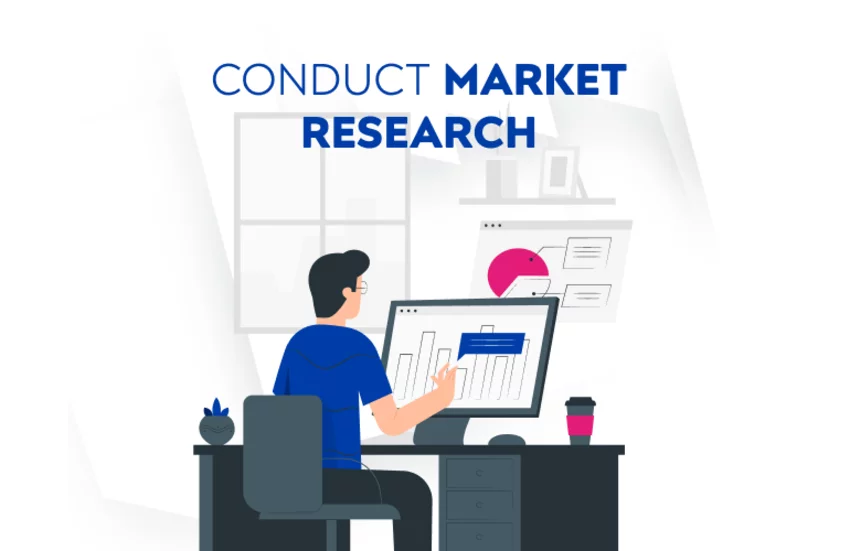
Research the industry
When you’re trying to settle down in an industry, you’ll want to know about it as much as you can. After all, you’re trying to influence it.
Now, you need to know its size, its growth rate, and the latest trends in the industry. We’re keen on recommending the following sources when researching an industry:
These sources are highly authoritative, and the chance is that you’ve already encountered them while researching ways to start an online marketplace.
So, give them a visit and start researching your industry as soon as possible.
Also, by researching the industry you’re trying to validate your business model. The size of an industry may be an important factor for you.
When you’re charging selling fees, for instance, it will be a lot harder to operate in a smaller market – even though it’s easier to enter it.
Next, you’ll want to know if there are some clearly defined niches in your market. It’s always a good idea to choose the most attractive niche you find in the market. But first, validate your business model!
To not get you discouraged, remember – Amazon, Etsy, and Eventbrite all started from small niches!
Today, Amazon is the largest online marketplace in the world, but it started way back in the 90s as a small online bookstore. The potential of your business is immeasurable.
Identify your competitors
Whatever industry you are trying to enter, you’ll have competition – either direct or indirect.

Without knowing your competitors, you’ll be fighting an uphill battle.
So, here are some questions to help you with your research:
- What niche is your competition in?
- How does their website look?
- What features do they have?
- How are they handling inventory and shipping?
- How do they describe their offerings?
- What kind of fees are they charging?
- How much effort are they putting into their marketing?
- How are they communicating with their community?
- What kind of guidelines do they set for their new sellers?
These are just some of the starter questions you’ll want to find an answer to. More will come as you continue with your research.
A good practice is to identify your competitors’ strengths and weaknesses and find some gaps which they didn’t cover.
List it all down in a spreadsheet, as it will be much easier to have a clear overview of your competitors.
Also, be sure to identify the market leader. Take a look at their business and try to figure out how they became the market leader. What separates them from the rest of the competition?
Next, you’ll need to identify your users.
Identify your buyers and sellers
Without knowing who your users are – you’ll be working on your online marketplace without a clear roadmap.
So, here are some simple questions that’ll help you get started.
- What are your buyers’ and sellers’ main goals and main challenges?
- Where are they buying, why are they buying and what seller do they buy from?
- What motivates and influences them?
With the help of these questions, it’ll be much easier to create a few buyer personas and better understand your target audience’s needs.
Also, here’s a checklist on what kind of actions could you undertake to identify your buyer personas.
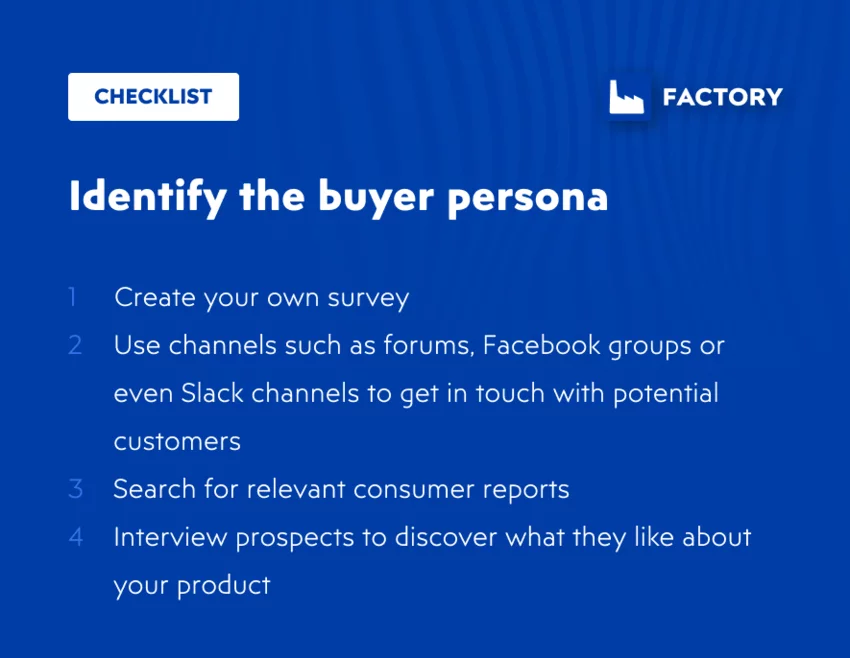
When you’ve identified your target audience, you’ll need to figure out what are their needs and what solutions can solve their problems.
You’ll want to find out more about your buyers and their shopping habits.
You could ask yourself the following questions:
- Are they shopping offline?
- Where are they shopping?
- Are they satisfied with their shopping experience?
- What else would they like to experience?
Also, when researching your potential sellers, you’ll want to get in contact with them directly. Ask them about their product offerings, how they plan to sell their products and what other platforms are they using to sell their products.
Find out how can you improve their experience as sellers and work towards that.
In the end, you’ll most certainly have a better understanding of your users. This will give you more insight into the market itself and make it a bit easier to plan the whole online marketplace business plan.
And now that you’ve researched your target market completely, it’s time to choose the business model for your online marketplace.
Choose the right business model for your online marketplace
Before launching your online marketplace, you’ll want to design a viable business model. Regardless of what industry you’re entering – this is necessary.
Here, you’ll want to decide how you’re going to monetize your online marketplace and what kind of revenue streams are you going to secure.
Here are some business models you may want to consider (including mostly different kinds of fees).
Charging sign up fees
By definition, a sign-up fee is a payment you charge your sellers to sign up to your online marketplace.
The good thing about this business model is that you can charge your sellers with sign-up fees before your online marketplace starts booming. As long as your idea is viable and concrete, you can sell it to your sellers and make them a part of your great journey.
The problem with sign-up fees is that they can’t scale. Also, you can’t charge the same seller twice for signing up. So, you’ll need some other sources of revenue.
Subscriptions
Subscriptions may prove to be the best business model nowadays.
The world economy currently is thriving thanks to these subscription-based businesses.
For example, you could charge your sellers a certain amount regularly in order to generate revenue. It will keep your business running and the more sellers you have – the more revenue is secured each month.
Following, here’s a snapshot from Amazon Marketplace. They charge their professional sellers monthly for $39.99 while, also charging them additional selling fees.
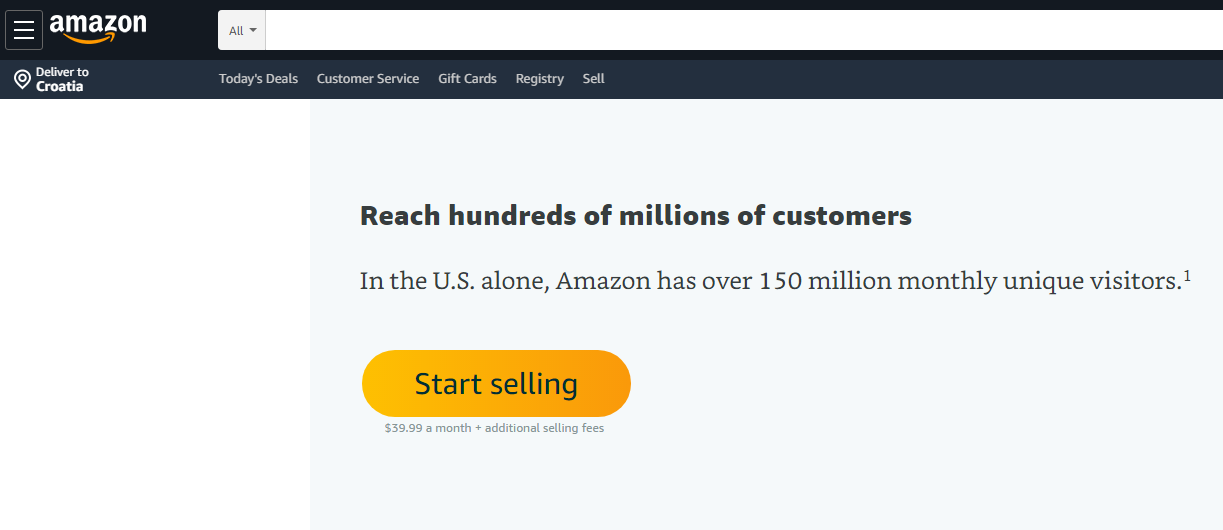
And if you go with a subscription business model, make sure your sellers get much more value than they’re paying for.
A fee of $50/month won’t mean much to them if they have an opportunity to earn 10 times the fee on a monthly basis.
Establishing subscriptions may be a bit difficult from a technical point of view. When dealing with subscriptions, you’ll want to have a payment gateway that supports subscription payments too.
But all in all, it’s worth it.
Charging listing fees
Besides sign-up fees and subscription plans, you could charge your sellers listing fees every time they list a new product.
The fee could be fixed or it can vary depending on the price of the product or its category.
Same as listing fees, they’re easy to collect. Still, they are much more scalable. For example, you could collect listing fees every time the product has been sold.
This makes it extremely scalable.
Charging selling fees
Selling fees are somewhat similar to listing fees but more scalable.
Every time your sellers receive and process an order, you’ll charge them a selling fee. Meaning, the more orders come through your online marketplace, the more revenue you can collect in selling fees.
A downside of selling fees is that they’re a bit more complex to implement, technically speaking.
Here you’ll need to have a payment gateway that can split the buyer payments so you can get your fee every time the sale has been made.
And to keep your online marketplace running, you’ll need to have more and more sales coming in. When you’re just starting out, this could be a challenge.
Nevertheless, it’s a great way to monetize your online marketplace.
If you’ve secured enough traffic to your online marketplace and the sales are steadily increasing, you’ll find yourself in a great situation.
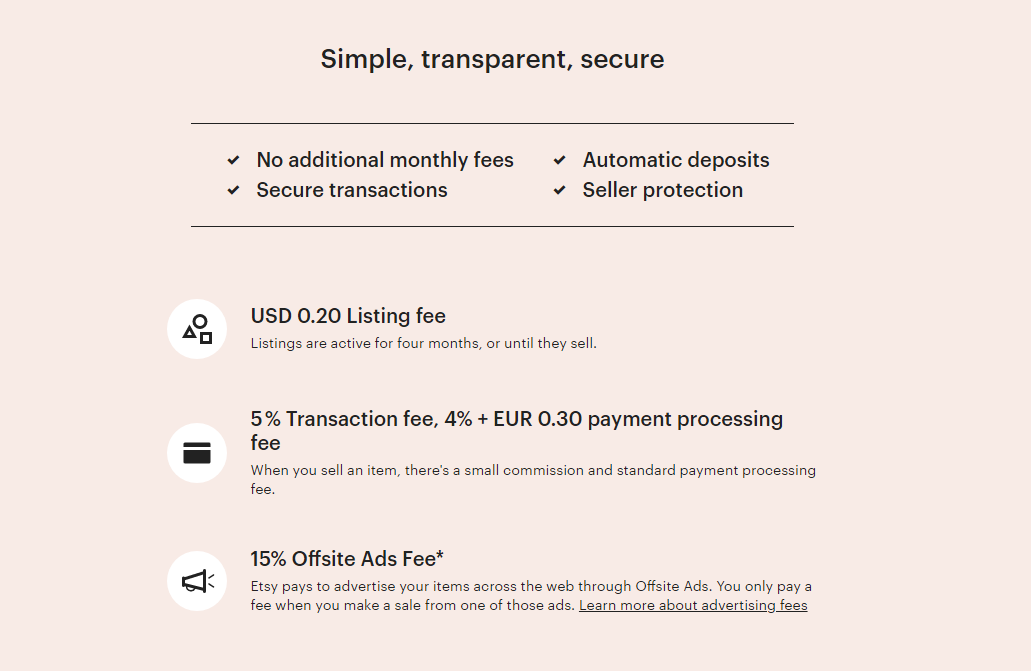
Many online marketplaces charge selling fees to secure their revenue. For instance, here you can see that Etsy charges a 5% transaction fee and a $0.2 listing fee.
The more value your seller can provide to the buyers, you’ll have more revenue coming in.
These are some basic ways to monetize your online marketplace. There are a few more monetization strategies and be sure to explore them before starting your own business.
After choosing the right business model, it’s time to start planning the technicalities of your online marketplace. Or so to say, start planning the operations in your online marketplace.
Planning the operations in your online marketplace
Managing your online marketplace can certainly get a bit complicated.
There is a large number of operations you’ll need to take care of and we’ll go through them in this section.
The main reason for this is that online marketplaces are two-sided businesses. You’re facing both the sellers and buyers. That means that you’ll need to take care of both of them and interact with them daily.
Let’s see how we can help you with this.
How to manage your sellers
Sellers are the main part of your marketplace and you’ll want to make sure that everything is in order regarding their operations.
You’ll want to be constantly acquiring new sellers and helping them while maintaining your relationship with the current sellers and bringing some value to them consistently.
First of all, your sellers will need a reason to join your platform.
That’s where the market research part jumps in. If you’ve done your research properly, you’ll know their strengths and weaknesses, their needs and wants.
After getting to know your sellers, create a set of landing pages just for them. Here, you’ll need to explain how your online marketplace works and why would it be great for them to join you.
Check out how Amazon creates its landing pages for its sellers. They’ve been doing a great job, considering the huge amount of sellers on their platform.
Here’s a video on how Amazon Marketplace works for B2B businesses. On their Youtube channel they’ve covered many topics regarding their business and marketplace in general, so feel free to check them out.
After you’ve set your landing pages, you’ll need to create a signup process. Here, you’ll decide who is eligible for selling on your platform and what kind of information you need from them.
Also, be sure to review every application you get, so there are no false registrations.
You’ll want to decide here just how much control will the sellers have over their stores. How much can they customize it and how can they execute their operations on the platform. What else will they do except for listing the products?
And a really important thing to remember here – you need to make it easy for them to upload their products. A too complicated process may just turn them away from your platform.
After you’ve successfully created a small community of sellers on your online marketplace, you’ll be dealing with a new challenge here – managing the products.
How to manage the products
In many cases, you won’t have to deal with your own products and your own inventory.
And still, you’ll need to take care of your sellers’ products, meaning you’ll have to manage their sold products.
To help you manage the products in your marketplace and keep your operations up and running, you may want to implement a product information system in your platform.
PIM systems will help you manage all of the products without all of the countless spreadsheets.
But, to make it clear from the beginning, there are 2 ways to manage your products and organize them.
- Every product belongs to exactly one seller (like eBay)
- Every product can be sold by multiple sellers (like Amazon)
This is an important decision, as it will have an impact on the selection of the software, the layout of your online marketplace, and the way your sellers manage their products.
So, you’ll want to make it as easy for sellers as possible to start selling on your online marketplace. You could offer them, for example, to import all of their products in bulk.
If they’re already running an eCommerce business, make sure to offer them a way to import their products from their website to your online marketplace.
How to process the payments
Processing payments for an online marketplace is a bit more difficult than processing payments for an eCommerce store.
You’ll need to allow your customers to purchase from several different sellers at once and split payments at checkout.
Here you’ll be collecting selling fees from every seller, depending on the product they’re selling.
To make sure this process works seamlessly, you’ll need to have a specialized marketplace payment gateway.
As you’ve already noticed, there are a few different types of payments and every payment has different requirements regarding implementation.
So, choosing the right payment gateway platform is a task of the greatest importance for your online marketplace.
In case you’re still searching for more info on payment gateways, check out this great video down below!
Keep in mind that you may need to take care of taxation, invoicing, and reporting as the owner of the marketplace.
Processing payments can get a bit complex when it comes to online marketplaces, and that’s one of the reasons why it would be good to find a reliable solution partner.
Next, you’ll want to know how to manage the logistics around your online marketplace. Let’s see what that’s all about.
How to handle shipping and logistics
Even though you’re not handling the inventory yourself, your sellers are.
That’s why you’ll need to make sure your online marketplace supports it.
You’ll need to define whether you’ll ship the products yourself and you’re going to leave that matter to your sellers.
Amazon is a great example of an online marketplace that handles the shipping through its Amazon FBA program. Check it out, it may serve you as an inspiration for this decision.
But it’s safe to say that if you’re handling the logistics yourself, it will get more complicated.
You’ll need to get the inventory from your sellers, store it in a warehouse and they ship it to their buyers. And for every different buyer, you’ll need to calculate the shipping expenses.
Considering all of this, we can say that Amazon is the number one online marketplace for a very good reason.
And in the other case, if your sellers are the ones responsible for shipping their products, you’ll want to make it easier for them. They will need a convenient way of managing the delivery of their products.
To make it more simple, you can use a flat rate, price-based, or even weight-based rules for shipping costs.
Keep in mind that every seller can specify different shipping rules to different locations. It largely depends on their choice of transport partners.
In any case, there are some important questions you should ask yourself, regardless of how you’re going to handle the logistics.
- Are you going to need some 3rd party tools?
- How are you going to track your shipments and handle the tracking numbers?
- How can you establish a standard SLA across your whole online marketplace?
When you’ve got this part of marketplace operations set, next you’ll need to make sure there are people constantly selling and buying on your marketplace.
And the number needs to be increasing.
How to handle marketing operations
Thanks to the network effect, your online marketplace will get enough traffic in order for you to enjoy a constant stream of revenue.
But still, you’ll need to make your online marketplace as visible as it gets. Especially in the early stages when you’re just starting out.
So, first, you need to find out how you can attract new sellers and buyers and make sure they stick with you.
Once you launch your online marketplace, you’ll want to think about how your online marketplace can keep growing.
You’ll achieve that through both organic and paid marketing campaigns.
Here are some common marketing channels you’ll want to get familiar with.
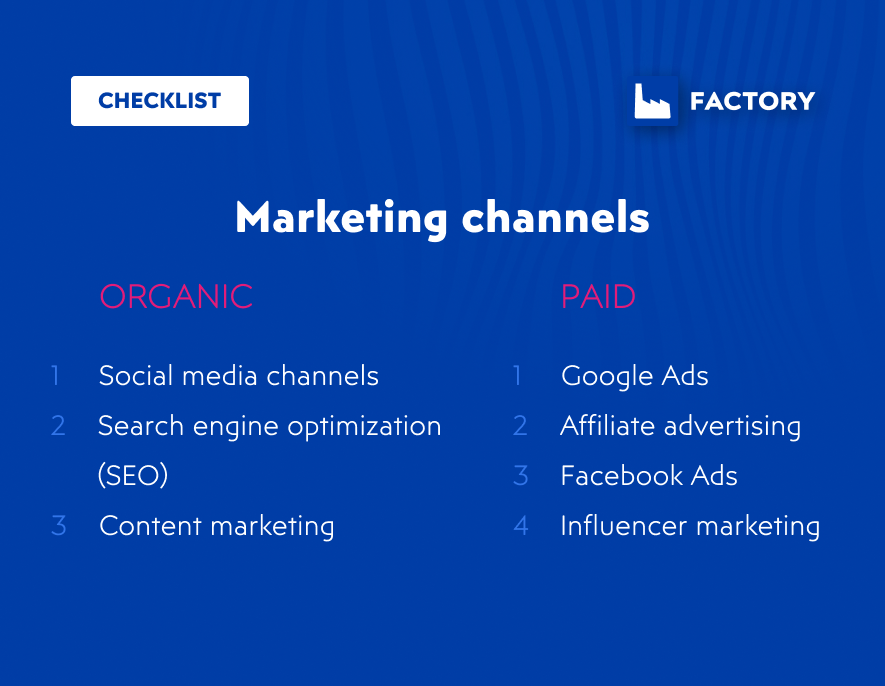
You’ll want to pay full attention to search engine optimization. Your online marketplace needs to be visible on the internet and putting in extra SEO efforts will make it worthwhile.
Many sellers on your marketplace won’t optimize their every listing for search engines, so make sure you make it as easy as it gets for them.
Otherwise, your online marketplace can be poorly optimized for search engines, and it won’t have any positive impact on your revenue.
You could even turn to voice search optimization and optimize your product listing for voice search!
The next thing you’ll want to do is make it easy for both your buyers and sellers to create content on your marketplace.
Your online marketplace could feature content such as product reviews, questions and answers, blogs, user-made collections and so on.
Also, you’ll want to avoid any low-quality content. Content moderation steps in to help you with this.
Not to mention you could get penalized by Google for having duplicate content.
All in all, you’ll need to overview all of the content created on your platform and make sure it’s relevant and high-quality.
Even though organic marketing channels will bring you great profits in the long run, you’ll want to use paid marketing tactics.
By using them, you’ll be able to improve your brand awareness and attract new buyers and sellers. How you’re going to use paid marketing channels depends mostly on your research.
And the final part of your online marketplace operations refers to managing relationships between your buyers and sellers.
How to manage buyer/seller relationships
Attracting both buyers and sellers is just the beginning.
You’ll want to make sure they are happy with your online marketplace and they’re loyal to your platform.
You’ll be interacting with them on a daily basis, helping them with their challenges, and answering their questions.
So, it would be really good if you’re prepared for these situations.
Every day, you’ll be bombarded with questions from your users, and to be honest – you’ll want to avoid being completely involved.
There will be questions regarding technical support, order-related questions, and even some disputes between your buyers and sellers.
To make it easier for you, you’ll want to ensure that your buyers can communicate directly with your sellers. Allow them to solve their disputes without you being involved, as the marketplace owner.
Provide your users with a range of communication options. Offering them more options to communicate will lower the chance of you getting directly involved.
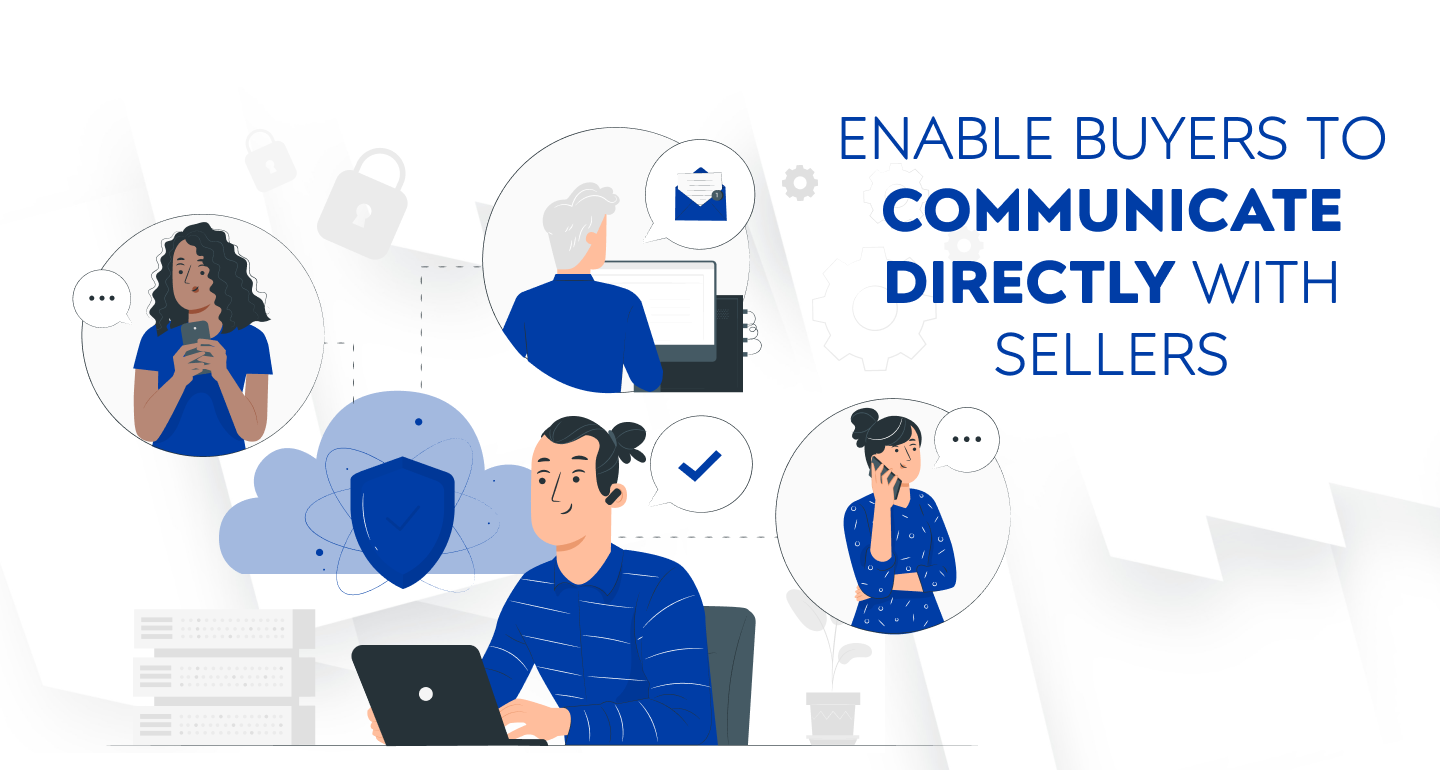
Also, it’s important to ensure you can notify all of your sellers about some new changes in the marketplace.
For example, if you’re publishing some new features to your online marketplace, you’d want to notify all of your sellers of the new opportunities you’ve just created.
Online marketplace features may differ from some traditional eCommerce website features, but you’ll see some similarities.
In essence, you’ll want to create a community around your online marketplace and turn it into a living organism.
It will grow and develop continuously, thanks to both your buyers and sellers. Sellers will most likely encourage you to bring some new changes to your marketplace that are going to positively affect their sales.
So, be sure to listen carefully!
Now, we move on to the 2nd part of this entire guide. We’ll talk about some essential features, payment solutions, different types of marketplace software, and finally – assembling a winning team!
Identify the essential features for your online marketplace
First of all, when launching your online marketplace, you won’t need all the features that pop in your mind right away.
The best way of building a successful marketplace is to start with a set of basic features and build upon them as the business evolves.
The whole idea here is to launch fast and add new features according to insights gathered from your data.
Now, there are 3 different sets of features we’ll talk about. To get a grasp on what we’ll talk about and how we’re going to build our features, here’s a short overview.
- Sellers want to sell products. This means we’ll have to enable them to list their products, sell their products, and dispatch them efficiently.
- Buyers want to buy products. This means we’ll need to enable them to search and buy the products as quickly as possible.
- The platform connects buyers with sellers and generates revenue doing it. This means we’ll need to establish a specific set of tools to support this.
Now, let’s start first with seller features.
Online marketplace features for sellers
Our goal here is to make sellers’ lives easier. To get this done, first, we need to make it easy for them to get started on your platform.
Quick and easy onboarding
The simpler the whole onboarding process, the higher the possibility of new sellers flocking into your online marketplace.
Here, we need to make sure that the signup and onboarding process are as straightforward as it gets.

Product management
First, you’ll need to have in mind that your vendors probably aren’t selling their products only on your platform.
They could have their own eCommerce websites, or they could already be selling their products on some other marketplaces.
So, you’ll want to make it easy for them to list their products.
When listing a product, a good product information management practice is to create simple product listing forms, all while having a convenient way for them to create different product variations and disbanding all of the non-crucial fields.
Another good practice here is to enable your sellers to import their products from third-party platforms such as Amazon Marketplace, Shopify, and so on. It could make the whole process a lot easier.
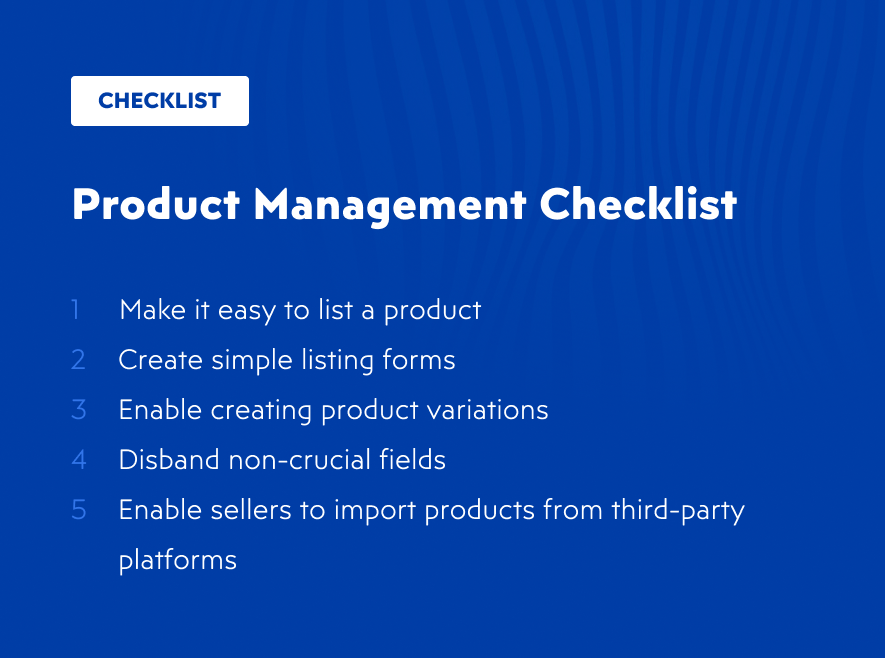
Convenient order processing
To minimize the amount of work your sellers need to do in order to process their orders, you’ll want to offer them a way of managing and processing all of their orders as efficiently as possible.
Every time your sellers receive an order, it would be great to instantly notify them while allowing them to mark those orders and print slips.
Along with that, a good practice is to offer a way of specifying the tracking numbers. Your buyers will appreciate it.
Listing promotion
Your sellers are here on your platform with one purpose – to sell their products!
So, it’s a good idea to enable them to increase their sales by promoting their products. Here, you could enable them to create and distribute their own coupon codes and even take part in discount campaigns. Moreover, you could even help them improve their sales through personalization and personalized experiences.
Quick sidenote: We’ve put in a huge amount of effort into Pimcore, a digital experience platform, that offers all of that and much more. Above, we’ve linked an article where you’ll be able to see what can you do with Pimcore’s personalization engine. Check it out!
Your end goal, by launching an online marketplace, is to connect buyers and sellers in a lucrative manner. This is one of the ways you can achieve it.
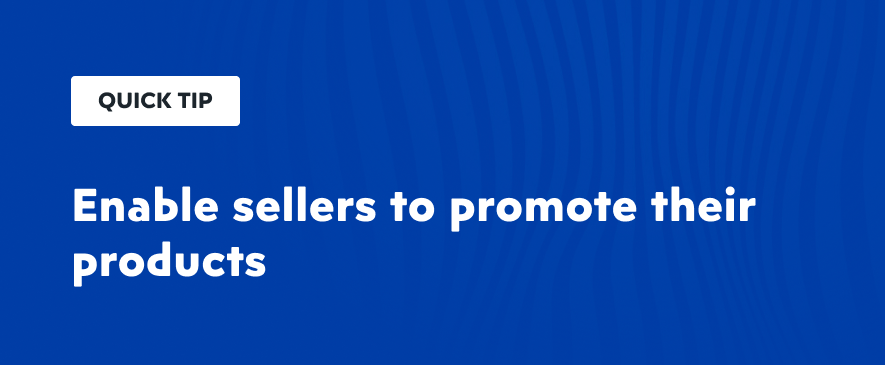
Communication tools
In our previous article, we’ve mentioned how important it is to enable buyers to communicate directly with sellers.
So, it’s a good idea to offer your sellers a way to receive and answer buyers’ questions, and also to receive reviews on their product listings.
Online marketplace features for buyers
Imagine yourself in a situation where you’re browsing some online marketplace.
You’re looking to find a product, purchase it, and receive it, quickly and easily.
So, our mission here is to make this whole process as easy as possible for your buyers.
Powerful search options
If your buyers can’t find what they’re looking for on your online marketplace, they’ll go somewhere else.
To bring the number of buyers exiting your marketplace to a minimum, a powerful search is a prerequisite.
According to research conducted by Baymard Institute, buyers are searching for products in many different ways.
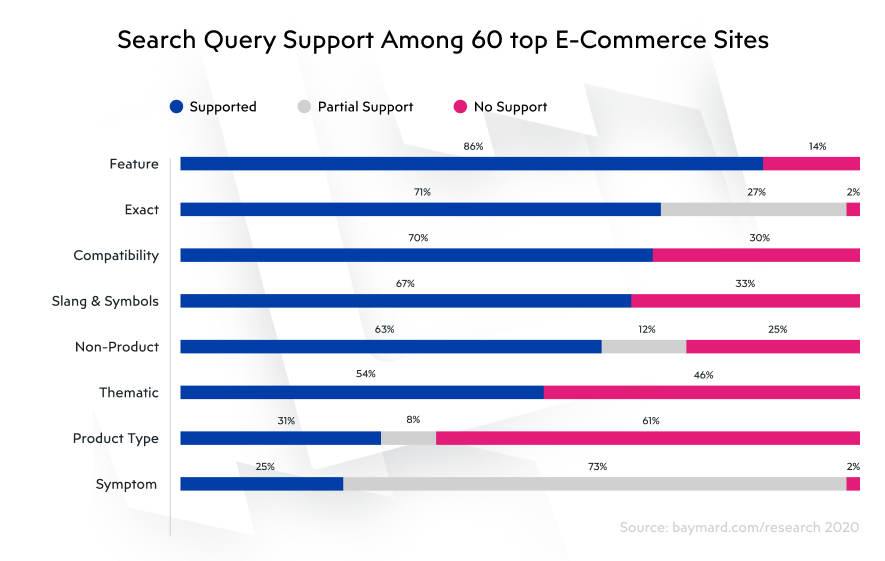
This type of insights can give you an idea of how your product search options may work.
Convenient checkout process
When designing a checkout process for your online marketplace, you’ll want to know more about your buyers.
Some questions you could ask yourself to clarify this a bit are:
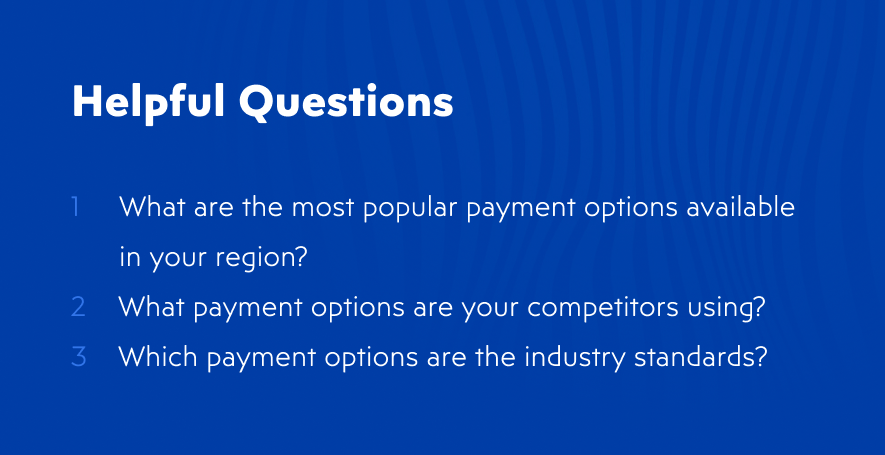
Make your checkout process as straightforward as possible and make sure you’re offering the payment and delivery options your buyers are already expecting to see.
Reliable order and tracking processes
If by any chance your buyers make an order your seller can’t complete, you’ll find yourself in a trouble and lose a customer.
You’ll want to avoid that and make sure your sellers are reliable. Enable your buyers to track their orders and notify them about every status change of their orders.
That way, your buyers will know what’s happening with their orders whenever they decide to check.
Communication with sellers
Whenever a problem arises, you’ll want it to be dealt with as soon as possible.
If your buyers can communicate with sellers even before they make an order, there’s a higher chance that they’ll purchase something on your online marketplace.

Online marketplace platform features
The goal of your online marketplace is to generate revenue by connecting buyers with sellers.
So, to make this happen you’ll need the right set of tools and features to support your online marketplace.
Let’s take a look at some features your online marketplace should have.
Suitable payment gateways
Payment gateways are essential to every website doing business in eCommerce, and online marketplaces are no exception.
You’ll need to make sure your online marketplace supports all the needed payment gateways.
Operation management tools
When running an online marketplace, you’ll want to stay up to date with all new activities happening on your platform.
To make sure you have control over your marketplace, you’ll want to consider features such as notifications, alerts, activity overviews, and tools for moderating catalogs.
Marketing tools
No platform ever became successful by staying hidden on the internet.
You’ll want to spread the word about your online marketplace and make sure you have a steady flow of users coming to your platform.
Besides paid marketing activities such as social media ads and Google ads, your marketplace will be much more visible if you decide to build it from the ground up having marketing in mind.
You’ll want to lay the groundwork for search engine optimization, making sure all of your pages are optimized for Google primarily.
Besides that, social media integration may play a huge role in marketing your online marketplace.
Also, the UX and UI design of your marketplace are of high importance. It can either make or break your online presence. Having that in mind, make sure you have a team of experienced designers dedicated to improving your platform.
Advanced analytics
When running an online marketplace, you’ll surely want to have a set of standard analytics tools.
Moreover, you’ll want to make sure your vendors also have those analytics tools available on your platform.
Still, when it comes to advanced analytics tools, developing one for your platform may prove to be a long and costly battle.
So, it would be great to offer an integration with some advanced analytics tools such as Google Analytics. Your vendors will highly appreciate it.
Besides these essential features and tools we’ve named here, there are many more that would be nice to have. When launching your platform, consider launching it with a standard set of tools and features and build more upon feedback.
All in all, these features are certainly similar to classic eCommerce website features (some are exactly the same, it’s still eCommerce, right?), and yet there are many more novelties.
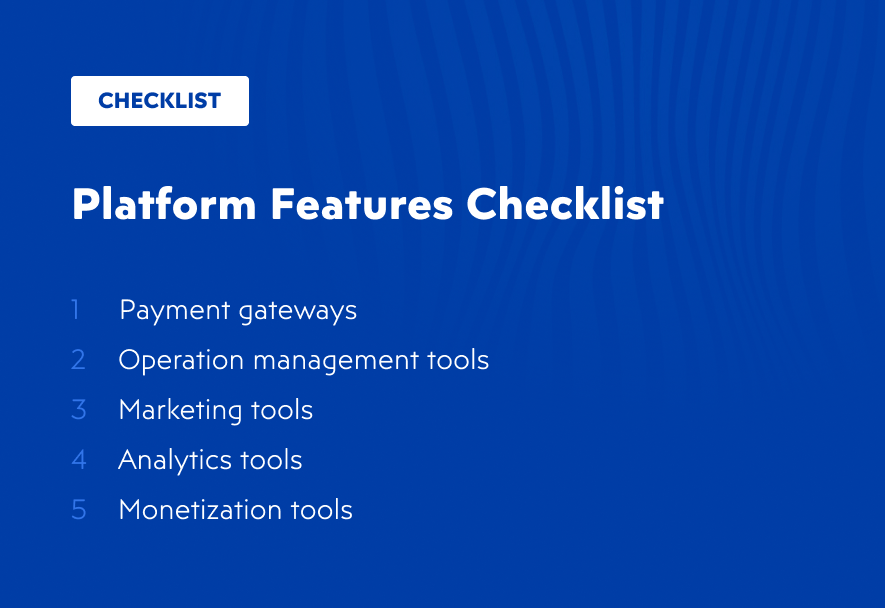
Choosing the payment solution for your online marketplace
To make sure your online marketplace business is sustainable, you’ll need to enable secure and reliable payment processing.
When compared with traditional eCommerce, there are a few differences when it comes to payment processing.
There are several different types of payments you’ll be processing on your online platform:
- Payments from buyers
- Payments from sellers
- Payments to sellers
- Payments to third parties
You can already see why solving the payment processing issue is going to be challenging.
To make sure that order payments are processed correctly, you may want to consider the following 3 ways of payment processing:
Direct payment
With this kind of payment processing, payments from your buyers will go directly to your sellers, meaning your platform will not be involved in this transaction.
If your platform doesn’t get involved in the transaction, some issues may arise.
You’ll have fewer opportunities to charge your transaction fees or to handle refunds.
Moreover, your customers will experience a major issue on your platform. They won’t be able to buy products from different sellers in one session and they’ll need to go through separate checkouts.
In essence, direct payments aren’t a great option when choosing a payment solution for your online marketplace.
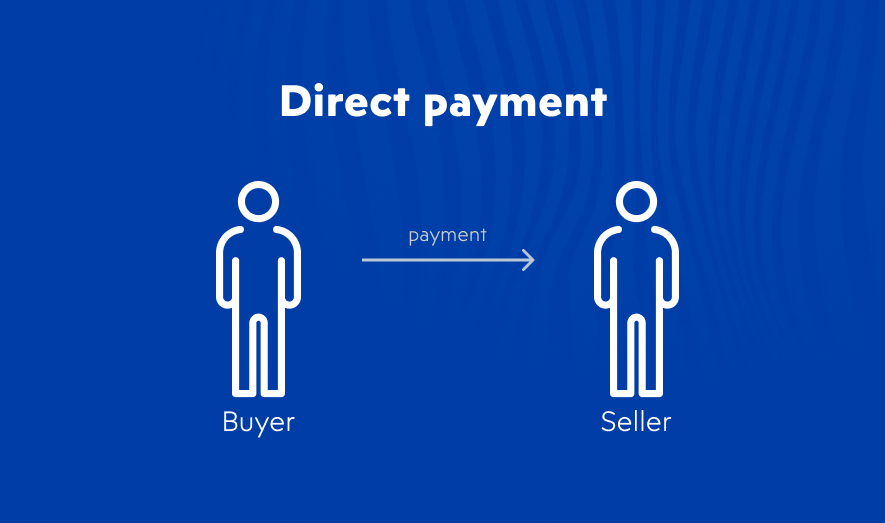
Aggregated payment
With this type of payment processing, your platform will collect all of the buyers’ payments and later redistribute it to your sellers.
This allows for a single checkout and handling refunds and returns, but you’ll need to put in extra effort to track your sellers’ finances.
This may prove as a challenge for your platform, so give it some thought before choosing a payment solution.
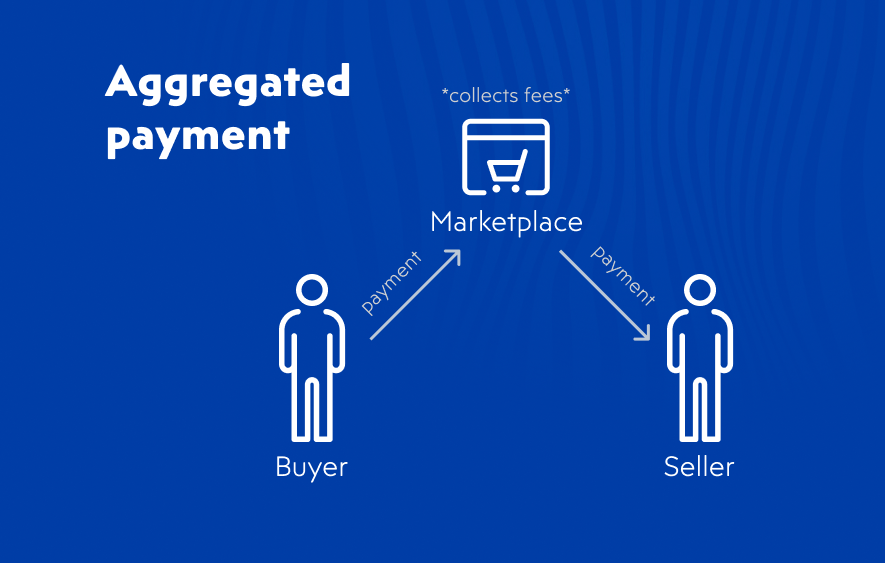
Split payment
When it comes to split payments, all of your buyers’ payments are split at checkout and distributed among your sellers.
And while it happens, you’ll be able to charge all of the fees and handle the transactions successfully.
Split payments solve the issues that appeared with the previous 2 types of payment processing.
One of the biggest challenges here is the complexity of implementing this kind of solution in your online marketplace.
Over the years, the situation has improved and now there are many payment processors that can handle split payments.
Some of these are Stripe Connect, Mangopay, and PayPal for Marketplaces.
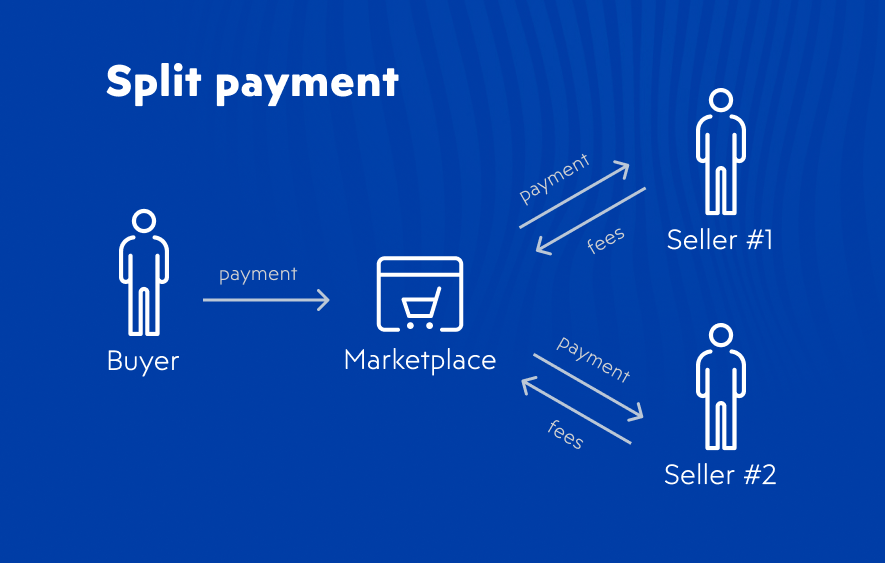
How to choose a payment solution?
Choosing the right payment solution for your online marketplace is of the utmost importance.
There are a few factors that will impact your decision, the most obvious one being the cost of the solution.
So, to make this decision a bit easier, ask yourself the following questions:

Try to find the right ratio between selling fees and payment processing fees, or you may end up with no profit at all after the payment has been processed.
Find the best online marketplace software solution
We’ve come to an important part of creating your online marketplace business.
After you’ve created the whole plan of operations, made the decision on the features and payment solution, it’s time to choose a software solution for your online marketplace.
There are many different options to choose from.
So, here are some tips on choosing the right one.
Consider what type of online marketplace are you building
Are you going to sell products, services or you’re going in the direction of online bookings?
Platform designed for online bookings may not work out well if you’re going to sell physical products.
Take into account the features you’ll need
You’ll want your online marketplace software to be able to support the features you decided to use.
Does it support the payment solution you chose previously? Can you implement the features you decided on already? How’s it going to handle logistics and shipping?
How good is its user experience?
This may get overlooked, but it’s extremely important. UX can make or break your online marketplace.
If it feels difficult to use and it isn’t as intuitive as you’d want, it probably isn’t the solution you’re looking for. The users will want the best user experience they can get their hands on and you need to make sure it all happens on your platform.
Who are the people building your software solution?
You’ll want to know who are the people working on your project and what kind of results can you expect from them.
An online marketplace often requires years of continuous support and updates, and you’ll want a reliable solution provided here.
When you find the right solution provider, the chance is you’ll be treating them more as a partner than just a solution provider. They’ll be heavily involved in your business and you’ll be able to turn to them regarding any issue on your platform.
Make sure to do your research when choosing a solution provider. Check their Clutch reviews, their previous projects, and their company culture. That will provide answers to many of your questions.
How big is your budget?
It’s safe to say, the budget isn’t a great priority when choosing a software solution.
Paying a few hundred dollars more today for a better solution can save you thousands of dollars in the long run.
Going with the cheaper solution usually isn’t worth it when it comes to the online marketplace business.
But still, defining a budget from the start is a good way to go.
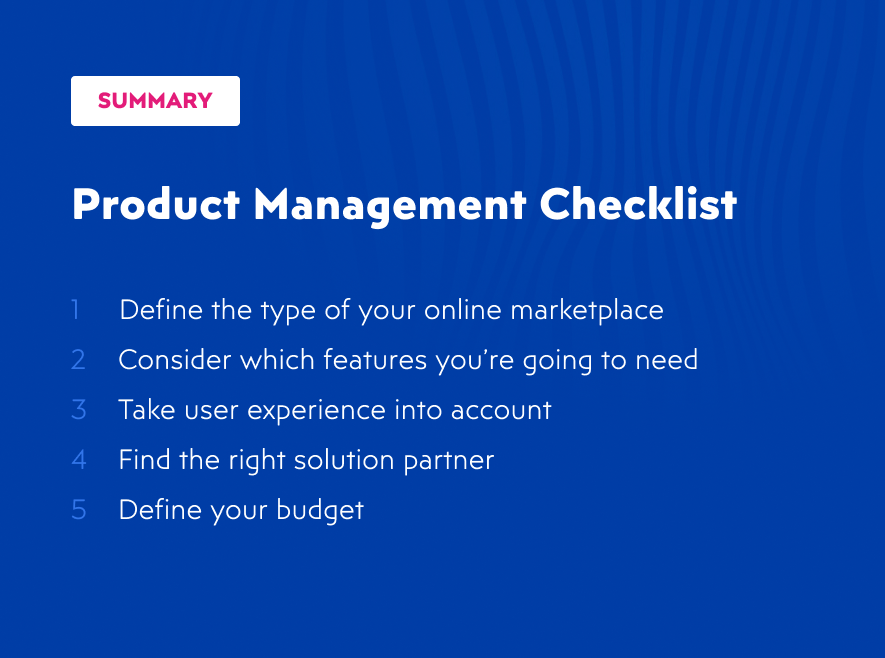
Assemble a great and reliable team
When running an online marketplace, you’ll need to have a great team that’ll help you make it work.
Here are some essential roles your online marketplace is going to need.
Designers and developers
Regardless of the software solution you choose, you’ll need to have some technical skills to pull it off.
You don’t need to be a developer or a designer, but you’ll surely want to have them on your team. It’ll make your life much easier.
Investing in both designers and developers can be extremely profitable in the long run, so have that in mind.
Marketers and salespeople
To get the most out of your online marketplace (and to get the business started), you’ll need to promote your online marketplace continuously.
That’s where sales and marketing come in incredibly useful.
Your marketers and salespeople will take care of finding both buyers and sellers for your online marketplace.
It’s safe to say that you’re also going to do both sales and marketing, ensuring your business is on the right track.
You may want to acquire some new skills such as:
- Email marketing
- Copywriting
- Social media marketing
- Community management
- Etc.
These are some basic skills when it comes to promoting your business and over time, you’ll most likely master them.
But don’t hesitate to invest in your team. Running an online marketplace is rarely a one-man job and if you’re aiming to go big – then it sure isn’t.
Online marketplace administrators
Running an online marketplace on an everyday basis is an exhausting task.
You’ll need to manage your sellers while keeping them happy, monitor everyday activities, resolve customer complaints, manage your team, do the paperwork, manage the payments, and so much more.
When just starting out, you may be the person that’s going to do almost everything, but you’ll surely want to delegate some of your work.
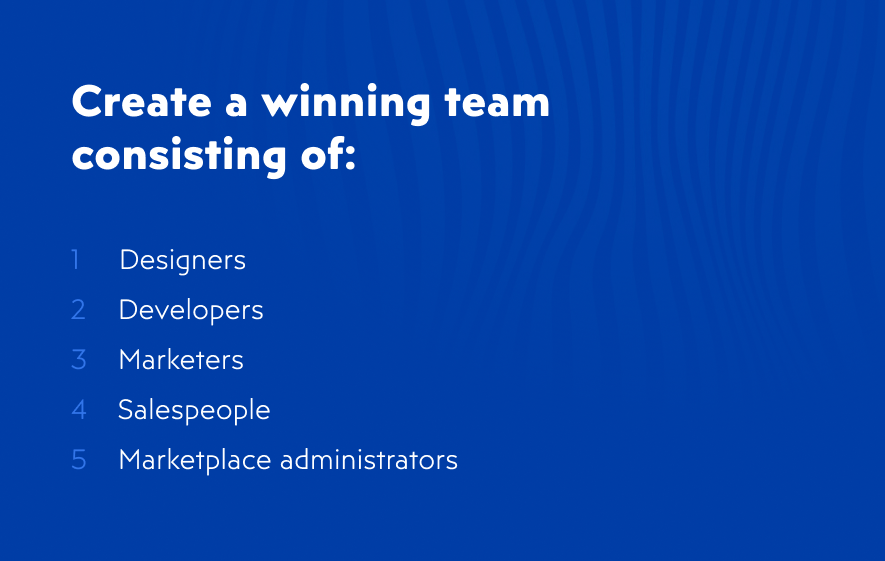
Consider hiring either full-time employees or agencies to help you out.
Each of them has its own pros and cons.
Recruitment and hiring is a long and thorough process, so be sure to put great effort into it.
It’ll most certainly pay off in the long run.
And now - onto the final part of this entire guide. You’ll learn more about actually building the platform, launching the online marketplace, and finally – implementing growth strategies.
Building the online marketplace
Now is the time to actually build the online marketplace.
If you’ve followed all of the steps from this article, we’ve got everything you need to start building the platform.
This process can take some time, and to make this process faster and easier, there are some things you’ll want to get done first.
Now, let’s get down to specifics.
Create a specification for your platform
We can all agree that online marketplaces tend to get complex. As far as eCommerce goes, online marketplaces are the most complex.
So, to avoid the troubles of running out of time and money and prepare yourself.
You’ll want to prepare some rough specifications that will contain more information about the project itself – its goals, requirements, and some kind of timeline.
A good rule of thumb is – the more work needs to be done, the more details you’ll want to have in your specifications.
To have a better overview of the implementation process, be sure to split the whole project into small steps. Set several milestones and keep track of it on a regular basis.
And when you’re defining the specifications, you’ll want to include your defined MVP in there.
In short, MVP stands for – minimum viable product.
We can define the minimum viable product as the version of a product with just enough features to satisfy first customers and provide you with needed feedback for further development.
So, we want to launch fast!
To launch the online marketplace fast, you’ll need to include some features that you need to have in your MVP, and an approximate launch date.
The more specific you get, the better.
After you’ve defined the specifications, there are more things you’ll want to master to build an online marketplace.
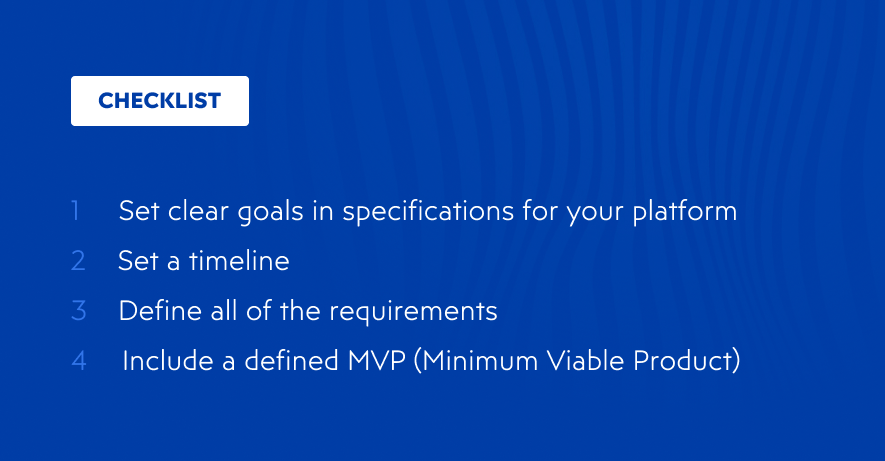
Obtain basic project management skills
To turn your idea into reality, you’ll want to have some basic project management skills at your disposal.
You don’t necessarily need to be a project manager, but you’ll want to know your way around.
If you’re working with an agency (such as us), you’ll have a project manager assigned to your project who’ll keep track of everything needed to finish the project successfully.
If you still decide to do it on your own, brace yourself for some unexpected situations.
Always have a backup plan for your project in case something goes wrong – and the chances are that something unexpected will happen during the project implementation.
For instance, if you’re dealing with freelancers, they could go unresponsive and leave you for quite some time without any proper answer.
Or some estimate on a specific feature may turn out wrong and you realize it’s going to take much longer to implement everything you planned.
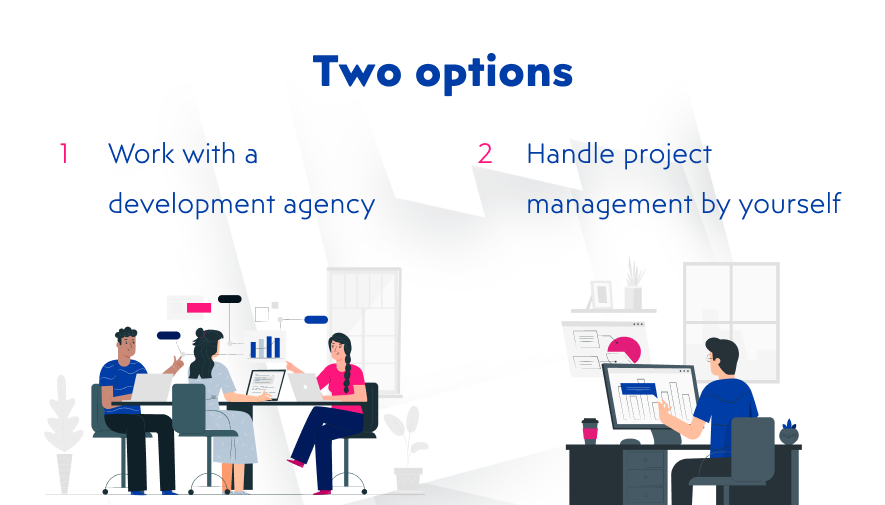
Launch at the right time
There are two mistakes you can make – launch too soon or launch too late.
Launching the online marketplace too late is the one mistake you’ll most definitely want to avoid.
So, as soon as your essential features are all set and you see the launch date drawing near, prepare for early user feedback and continuous testing.
It will take a while until you hit the right spot with your online marketplace, but you know the saying – Rome wasn’t built in a day!
And now comes the most exciting part of this whole process – launching the online marketplace!
Launching the online marketplace
Now, creating a website isn’t even remotely enough.
There are a few things to consider when launching the online marketplace.
First, be sure to launch the marketplace in 2 phases – soft launch and hard launch.
But before you’ve done that, you’ll want to set some plans.
Plan out your launch
The sooner you start planning, the better.
This means that you’ll have more time to spread the word about your upcoming launch and ensure a list of early users.
Your launch plan will consist of a launch timeline, your marketing efforts and messaging, and a list of all of the communication channels you’re going to use.
This largely depends on what country you’re launching in and what market you’re entering.
So, while your website is still under construction, build some excitement in your target market and ensure that you have a number of buyers and sellers right after you launch the online marketplace.
By building excitement, we mean using marketing strategies to reach out to your target users. You could use paid ads, or even reach out to them on social media.
When talking about acquiring sellers, be sure to get in touch with them directly.
By the time you’re doing a soft launch, you’ll need to already have some users who are willing to use your platform, either for selling or buying.
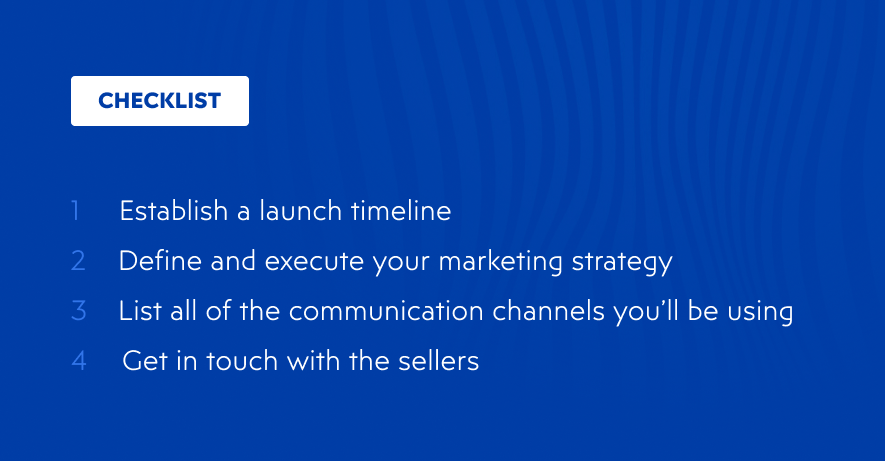
It’s time for a soft launch!
In the beginning, you’ll face many challenges such as numerous bugs and usability issues.
That’s why you don’t yet want your online marketplace to go public.
It’s a good idea to do a soft launch with your early users as soon as your MVP is ready.
If you’ve planned out everything right, you’ll already have a mailing list of potential users.
First, reach out to your new sellers and help them set up their stores on the marketplace.
Once you’ve done this, it’s time to get the ball rolling. Invite all of your potential buyers to check out the platform and see how they’re doing.
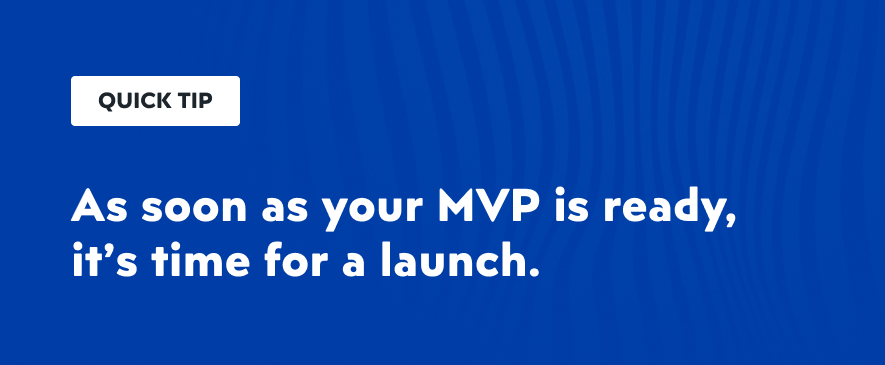
Test everything and shiny up your online marketplace
After your users have settled in your online marketplace, you’ll want to gather as much feedback as possible.
Contact the users directly and ask them a few questions about their experience on the platform.
Now’s the time to listen. Every bit of feedback is crucial and you’ll see what your users want to experience on your platform – and you’ll see what they don’t want to.
After the initial feedback from your soft launch, take your time to improve your online marketplace as much as possible.
An important note to make – make sure to create real relationships with your users. In the early days of your online marketplace, those loyal users will be your best promoters.
Once you’ve polished your online marketplace – it’s time to go public!
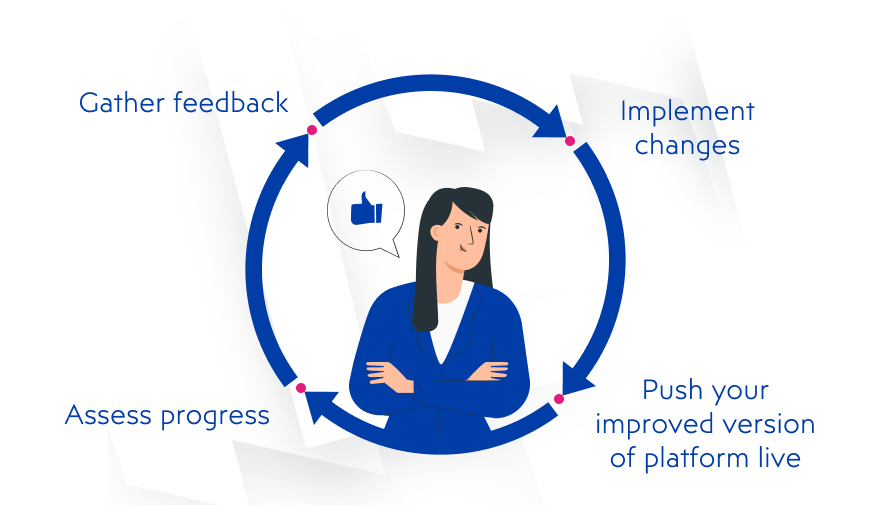
It’s time for a hard launch!
Before you go public, be sure to test everything once again.
If everything seems to work great, here you are – at the most exciting part of your online marketplace journey.
Get your whole team ready for the launch. Some unexpected issues might happen when you want it the least.
Try to make your launch an event. Get people talking about it, bring them in through webinars, Q&As, and various different activities. You’ll want your users to be excited to be one of the first ones on the platform.
And after everything starts going and users start flowing in, you’ve hit another milestone – the journey is far from over.
Go big with your online marketplace
Now’s the time to grow your online marketplace.
You’ll need the new users flowing in and the current users to keep using your platform.
Growing an online marketplace will be a bit different than growing a traditional eCommerce business.
Here, you’ll need to focus on both buyers and sellers, while the traditional eCommerce business tends to focus on buyers only.
As soon as you launch the online marketplace, you’ll want to have as many sellers as possible – and you’ll want them to keep doing business on your platform.
Finding the first sellers for your online marketplace
You surely don’t want your buyers to visit your marketplace and find out there are 30 empty categories and just a few products in the marketplace altogether.
To make sure this doesn’t happen, you’ll want to have a number of sellers as soon as possible.
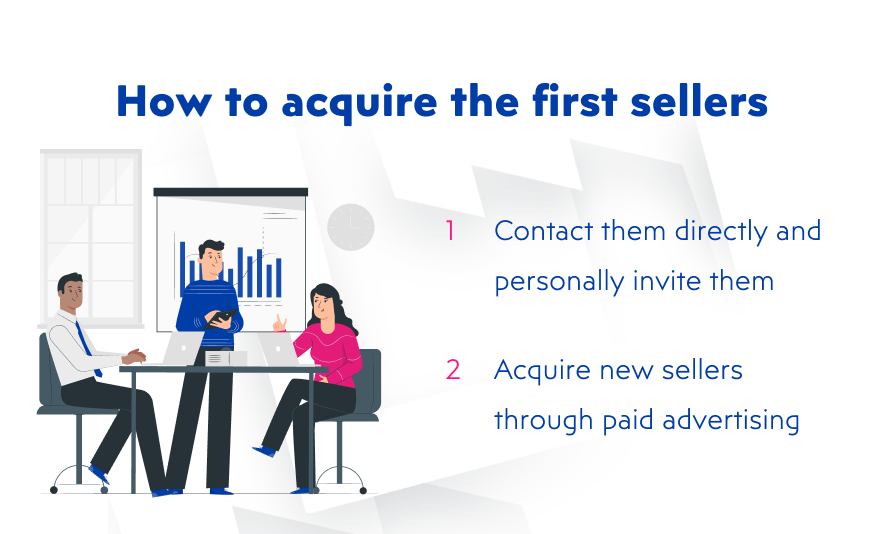
Thanks to your thorough market research, you know exactly who your sellers are and where you can find them.
Contact each seller that may be interested in offering their products on your online marketplace. The more sellers you have from the start, the better.
And be prepared to get rejected quite a few times.
But a great number of sellers will agree to join you. Try building real relationships with them from the start and offer them something of value.
Make sure their onboarding process is free and that they don’t need to pay any fees when just starting out.
Fees will surely come along the way, but first, make sure that your sellers have a great experience doing business on your platform and that they’re here to stay.
Focus on bringing in more buyers
When your sellers get settled and they’ve already set up their stores, it’s time to invite more buyers.
Now, this part will work the same as it does in the traditional eCommerce business. And still, you’ll have more categories, products, and features to offer your buyers that you couldn’t possibly offer them handling it all by yourself.
Just take Amazon for example. You can find almost anything there. There are so many sellers that you can always see new groups of Amazon seller groups popping up and discussing the best strategies.
Paid advertising and social media channels are the way to go when focusing on acquiring more buyers.
As with anything you’ve done by now, you’ll need to test each channel you’re going to use to find out which channels work best for you.
And while you’ve been building your online marketplace, you made sure it’s optimized for the search engines. The platform you picked is SEO-friendly and you’re focused on winning in the long run.
After your sellers start flocking in and setting up their stores, your website’s SEO ranking will start growing and attracting more new users, both buyers and sellers.
After some time, there’s potential for your online marketplace to even become self-sustainable in terms of user growth.
To make it clear – you’ll want to analyze how your marketing campaigns are doing and how does your website analytics look like.
Using tools such as SEMrush and Google Analytics is going to be crucial for identifying some bottlenecks in your marketing campaigns.
Keep the users happy – focus on retention
Once the users are flowing in, you’ll want to keep them on your platform.
When acquiring new users, there’s always a risk of them leaving your online marketplace and never coming back.
So, make sure that your users are happy with your platform and that they’ll keep using it.
And you’ll still want to gather feedback continuously to improve your eCommerce features (or even add some new ones).
To make your platform easy-to-use, create an FAQ page. And make it pretty detailed because – online marketplaces tend to get a bit complex, right?
Also, you definitely want your sellers to be successful. So, create a guide for them that will help them sell more of their products.
The more product your sellers can sell, the more fees you can charge. It’s a win-win situation!
If some of your sellers tend to stand out with their successful store on your platform – why not feature them?
Create a case study of their business or cover their success story in your blog section. This will certainly make them happy, while also boosting your SEO ranking.
As time goes, try to get a hold on conversion rate optimization and advanced analytics. This will help ensure your online marketplace is doing a good job of converting more users.
And if it isn’t – you’ll know exactly what you need to do to make it happen.
P.S. Always keep your software up to date! You want your platform to be highly-secure at all times.
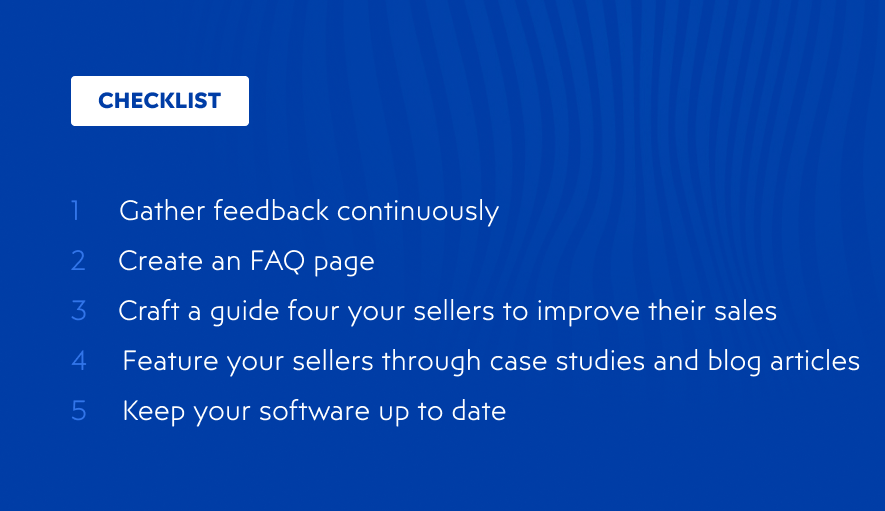
Experiment with new features and partnerships
If you’re new to the market and you’re aiming to beat your competitors, think about relying on some new and experimental strategies.
To beat your competitors, you’ll certainly need more than a regular growth strategy.
Try offering some new and unexpected features and benefits to your users by bringing in some new tools, services and partnerships.
Check out your competitors and find out what kind of tools and features they aren’t still using.
You could partner up with local businesses, reach out to industry-specific magazines and engage in trade shows.
Whatever your strategy may be, always keep experimenting with new features and – test, test, test!
This was a really long ride!
We’ve come to the end of our online marketplace series!
If starting and running an online marketplace seems less scary for you than before, our goal is complete! 🙂
You've got all the information on where to look when starting and building an online marketplace - but if there's more you'd like to know, be sure to check our blog more often!
And if you’re in need of service in online marketplace development, we’re here to help.
We’ve been building successful online businesses for more than 8 years and we’ve got tons of hands-on knowledge and experience behind us.
If you’re ready to start your online marketplace, reach out to us – we’d like to hear more about your idea!






